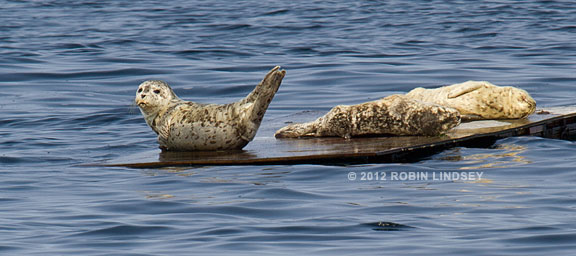Thin isn't "in" for seal pups
Sep/25/12 11:34 PM

This season we are seeing too many terribly thin pups and not enough chubby ones. Unlike our two-legged species that is obsessed with being thin, skinny is not a good thing for harbor seal pups. A good blubber layer is essential to keeping pups warm and providing energy - it is truly life sustaining. The alert pup shown in the photo above, although hardly robust, is in stark contrast to the two emaciated ones sharing the raft off Alki Beach.
Unlike northern elephant seals who have such a thick layer of blubber that they spend 10 months a year at sea, harbor seals need to haul out daily for many hours to rest and warm up - they can’t maintain their body temperature in the cold, cold waters of Puget Sound. And a struggling pup with a thin layer may spend even more hours out of the water. A good blubber thickness for a healthy weaned seal pup is 2.9 cm. The two pups resting on this raft have a much thinner blubber layer - most likely less than half that of a thriving pup. These pups need as much rest as they can get and we are thankful for the waterfront owners who established these off-shore rafts. If you are interested in plans for building and securing rafts, please contact us.
Why are our pups so thin? In a 20 year WDFW study of seal pups in South Puget Sound, statistics reveal that a Northwest pup usually weighs about 18-22 lbs (8-11 kgs) when born. They quickly gain weight, feasting on mom’s milk which is almost 50% fat, and should weigh close to 45 lbs (18-21 kgs) when weaned after 4-6 weeks. Pups that have had an attentive mom are truly “blubberballs”, rotund enough to survive the transition to foraging on their own. However, a pup can easily drop back down close to birth weight within a month of weaning depending on fishing skiils or if food sources are diminished. Over the past two years it seems that there has been a bounty of small fish, squid and shrimp for our pup population. While we still had quite a few deaths as with each season, we also had many thriving pups. Not so this year. However, the recent return of the fishermen may bode well in one respect for the seal pups: where there’s big fish, there’s the bait fish that pups depend on. SeaDoc Society just completed a study about changing foraging habits of the Common Murre (sea birds that nest on Washington’s Tatoosh Island) as food sources diminish in the Salish Sea. The Murres are dependent on declining “energy-rich prey”, in particular the same herring and smelt that sustain our pups (read about it here).
As we have stated many times, a thin pup is significantly more at risk for opportunistic parasites and viruses. Hopefully, the fall fish runs will bring lots of bait fish to fatten up our pups and bolster their immune systems. Blubber is a beautiful thing.







